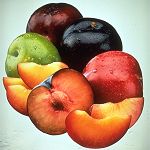


|
HOME EARLY SUMMER · Apples · Apricots · Apriums · Artichokes · Cherries · Figs · Grapes · Nectarines · Peaches · Plums · Pluots MID SUMMER · Apples · Artichokes · Asian Pears · European Prune-plums · Figs · Grapes · Mangos · Nectarines · Peaches · Pears · Plums FALL · Apples · Asian Pears · Grapes · Kiwi Fruit · Oranges · Pears · Persimmons · Pineapple · Plums · Pomegranates WINTER · Apples · Asian Pears · Avocados · Grapes · Grapefruit · Kiwi · Kumquats · Oranges · Pears · Strawberries · Tangerines COMPANY CONTACTS |
Plum Fruit Facts and Information | |
|
Locate a Gift Catalog with Plum Availability by Variety Recipe Search & More Information | |
 PLUMS
are hard-pitted fruits like peachs, cherrys, almonds, and apricots. About 12 plum species are cultivated throughout temperate regions for their fruit and as flowering ornamentals. PLUMS
are hard-pitted fruits like peachs, cherrys, almonds, and apricots. About 12 plum species are cultivated throughout temperate regions for their fruit and as flowering ornamentals. The common European plum, the most important species, has been cultivated since ancient times and probably originated near the Caspian Sea. It was introduced into North America, possibly by the Pilgrims, and is now mostly cultivated in the western United States, California in particular. Fruits of varieties of this species range in color from yellow or red to green, but purplish-blue is most common. Dried plums, or prunes, are made from the varieties that are richest in sugar and solids. The Japanese plum, probably originating in China, was introduced into the United States in 1870. The fruit is more pointed at the apex than that of the common European plum, and its varieties are yellow or light red but never purplish-blue. The Damson plum-a small, oval, sweet fruit used mostly in jams-was first cultivated in ancient times in the region of Damascus.
How to Store:
Nutritional Facts: |